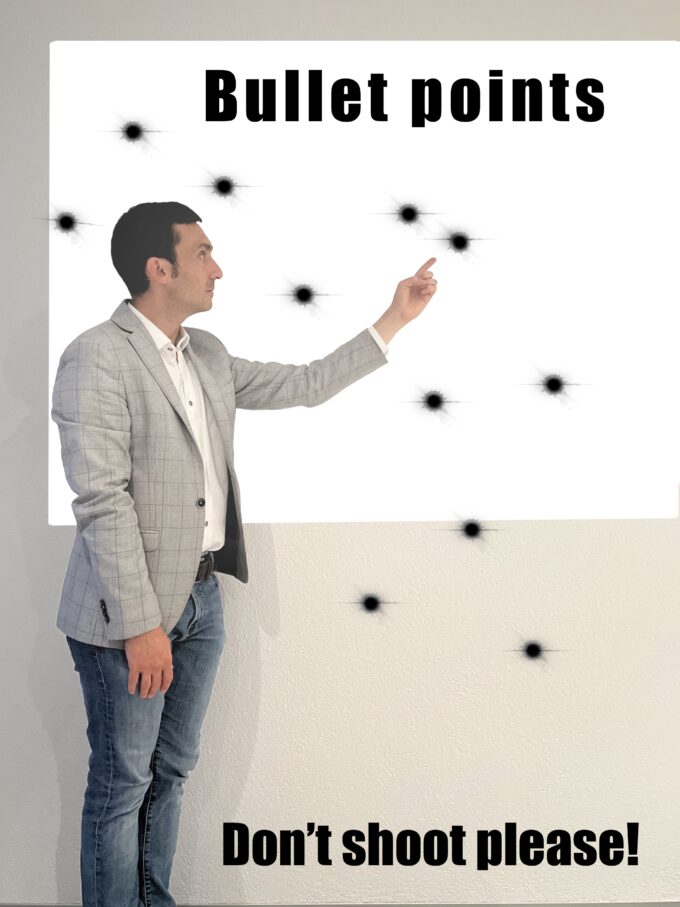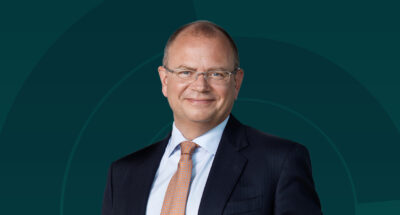
How to teach an entrepreneur to let go
Biotech entrepreneur Juana Lucia Flores-Candia explains that technology has changed the way to mentor chief executives. Here are her three ways to get entrepreneurs to focus....

by Susan Goldsworthy, Peter Meyers Published 17 October 2023 in Leadership • 9 min read
Harvard linguist Steven Pinker famously said, “Language is a window into human nature.” Indeed, it mirrors the undercurrents of how we view success, collaboration, and competitiveness. Language shapes our thoughts – and our thoughts shape our behavior.
There’s growing concern over the aggressive, often war-like metaphors and imperialist, mechanistic terminologies that are still rampant in business parlance today. We’ve normalized a culture of domination in our speech patterns that runs so deep we often don’t even notice it’s happening.
Most of us use over 7,000 words per day – that’s about 50,000 words a week, or 2.5 million words per year. (War and Peace has only 600,000 words but it can take a year to read.) How many phrases per day come out locked and loaded, taking a shot at explaining something using metaphors from war?
If we listened deeply, we’d likely be shocked at how often we’re shooting, battling, and killing in our everyday speech without even noticing it. If this article is already triggering you, please don’t shoot the messenger as we take a stab at showing an alternative approach to the question: Does this language serve the sustainable, inclusive, collaborative future we envision?
We’re all familiar with commonplace terms like deadlines, bullet points, and must-win battles during office meetings. These aggressive terminologies paint a picture of business as a battleground.
Deadlines invoke a do-or-die scenario, bullet points mirror ammunition, and must-win battles pitch enterprises in a relentless fight for dominance. We rally the troops, arm the team with facts, set up targets and put boots on the ground to divide and conquer. We have a headcount on the front lines to face uphill battles, but with a few more bullet points in our slide deck, we’re going to kill it this quarter. We talk about outflanking the competition and defending our turf but are these the terms that will lead to the kind of purpose-driven culture that we need?
While these terms may drive urgency and focus, they also perpetuate a culture of stress, burnout, and relentless competition. Organizations are then modeled as territories to be defended or expanded, with employees becoming expendable human resources. Companies create jobs but people lose theirs (like a set of keys?). In such an environment, success often becomes synonymous with survival, neglecting aspects like collaboration, innovation, and holistic well-being.
Historically, business terminology has often been steeped in metaphors and idioms reminiscent of imperial, colonial, and patriarchal worldviews. These terminologies more often than not originate from or echo power dynamics that have informed many aspects of society, from economic frameworks to sociopolitical structures. The lexicon used in business environments can offer insights into deeper, often unexamined assumptions about power, control, and value.
Many business terms carry with them the vestiges of colonial and imperial epochs. Consider phrases like “frontier markets” or “pioneering a new market,” which suggest the exploration and conquest dynamics reminiscent of colonial expansion. Similarly, “dominating a market” or “capturing market share” evoke a sense of conquest and control.

“By recognizing and addressing the colonial, imperial, and patriarchal undertones in our terminologies, we not only pave the way for more equitable business practices but also challenge and transform deep-seated power structures that have persisted for centuries.”
The colonization narrative has often centered around the extraction of value, with resources (both human and natural) in ‘new’ territories viewed primarily as inputs to fuel the growth and prosperity of the colonizing power. Similarly, traditional business models have been largely extractive, focusing on deriving maximum value from available resources with minimal regard for sustainability or local well-being.
Patriarchal structures, defined by male dominance and a hierarchy of power, have left their mark on business rhetoric too. Terms like “chairman” or “manpower” are not just gendered in their tone but also denote a specific power structure. Moreover, aggressive and assertive behaviors in business, often described with phrases like “killer instinct” or “take no prisoners,” resonate with traditionally masculine traits, sidelining qualities like collaboration, empathy, and nurturance.
Driven by the aforementioned imperial and patriarchal values, businesses historically have leaned towards an extractive model, which emphasizes the consumption of resources to generate profit. This has been sustained by a language that prioritizes “exploiting resources,” “penetrating markets,” and “maximizing gains.” Such terms, even if used innocently in modern contexts, have historical undertones of unbridled extraction without due regard for sustainability or reciprocity. By recognizing and addressing the colonial, imperial, and patriarchal undertones in our terminologies, we not only pave the way for more equitable business practices but also challenge and transform deep-seated power structures that have persisted for centuries.
Equally concerning is the mechanistic language that dominates boardrooms. Phrases like “engine of growth” and “key performance indicators” reflect a vision of businesses as machines. We even refer to organizations as well-oiled machines. We refer to employees as ‘cogs in the machine:’ referring to individuals or teams as mere components in a larger system, often highlighting their replaceability or lack of individual significance. We speak of ‘gearing up:’ in preparing or equipping a business for increased activity or a new venture, and about ‘switching gears’, referring to changing tactics or strategies in reaction to new situations or data.
Companies that operate solely on the mechanistic model emphasize efficiency, predictability, and control. However, this may sideline human elements like creativity, empathy, and flexibility. If a machine breaks, parts can be replaced. If a living system breaks, it’s not so easy to ‘fix’. Machines can also run 24/7 whereas people cannot function without sleep.
This mechanistic nature inadvertently sidelines sustainability. Just as machines require fuel, businesses in this model voraciously consume resources, often with scant regard for long-term ecological balance.
If language mirrors our aspirations and values, then it becomes imperative to re-evaluate our linguistic choices in business – especially if the goals are sustainability, inclusivity, and collaboration. We must transition from a “power over” approach, where competition and dominance reign supreme, to a “power with” perspective, emphasizing collaboration, empathy, and shared growth.

Rather than envisioning businesses as battlegrounds or machines, imagine them as ecosystems. In nature, ecosystems thrive on balance, diversity, and interdependence. Similarly, organizations can become spaces where diverse talents converge, fostering an environment of mutual growth. Instead of “deadlines,” we could have “due dates.” In place of “must-win battles,” why not “collaborative missions”?
Ecolinguistics examines how language both reflects and influences our understanding of the natural world and our place within it. Pioneers in the field, like Arran Stibbe, emphasize its transformative potential. By understanding and reshaping the way we talk about and conceptualize the environment, there’s potential for fostering more sustainable behaviors and policies. In a world grappling with environmental challenges, ecolinguistics offers tools to navigate and reshape the narratives that define our ecological relationships. Ecolinguistics aims to bring to light the often implicit assumptions, beliefs, and values within language that can contribute to environmental harm or, conversely, ecological harmony.
As the modern business environment grows more complex, interconnected, and conscious of human elements, there’s a shift towards using organic metaphors. These metaphors often derive inspiration from nature, ecosystems, and human experiences, emphasizing adaptability, growth, and interconnectedness. Here are a few examples:

These organic metaphors not only reflect the more human, adaptive facets of modern businesses but also resonate with the growing emphasis on sustainability, interconnectedness, and holistic growth. As the world grapples with challenges like climate change, resource depletion, and social inequalities, such metaphors become increasingly relevant, emphasizing harmony, balance, and shared prosperity.
Transitioning to this new linguistic paradigm isn’t merely a matter of political correctness: it’s a strategic move. Here are three reasons why we would all benefit from changing our business language.
The “power with” approach challenges the deep-rooted notion of winners and losers. It promotes a world where success isn’t a zero-sum game. For instance, instead of aggressive market “penetration,” we could aim for market “engagement.” This subtle shift underscores a more collaborative approach with consumers, understanding their needs and co-creating value.

“Rather than envisioning businesses as battlegrounds or machines, imagine them as ecosystems.”
Additionally, as businesses embrace global operations, a less combative language fosters better cross-cultural communications. Many cultures value harmony, collaboration, and community over competition. Instead of ‘playing to win’ we can ‘play to thrive.’
The words we choose in business are not inert. They shape perceptions, drive behaviors, and create realities. Stibbe emphasizes that the way we talk about nature, animals, and the environment is not neutral. The words, metaphors, and narratives we employ can either reinforce or challenge dominant ways of thinking about the natural world. For instance, viewing nature purely as a resource to be exploited can lead to very different actions than seeing it as a network of interconnected, sentient beings.
As we stand at the crossroads of an era demanding sustainability and inclusivity, our language must reflect these priorities. By shifting from combative, colonial, mechanistic metaphors to a more organic, ecosystem-based model, businesses can be better equipped for a future where success is collective, growth is sustainable, and every stakeholder thrives. In the end, the language of business contributes to the making, or breaking, of the world we want.
As society becomes more conscious of the implications and origins of its language, there’s a growing emphasis on reshaping business lexicons. The transition towards more inclusive, sustainable, and holistic business practices necessitates a parallel evolution in language. By understanding the profound impact of language on our perceptions and actions, we can begin to craft narratives that foster respect, care, and interconnectivity with the natural world.

Affiliate Professor of Leadership, Communications and Organizational Change at IMD
Susan Goldsworthy OLY is an Affiliate Professor of Leadership, Communications and Organizational Change at IMD. Co-author of three award-winning books, she is also an Olympic swimmer. She is a highly qualified executive coach and is trained in numerous psychometric assessments. She is Director of the IMD Executive Coaching Certificate.

Founder of Stand & Deliver Consulting Group
Peter Meyers is the founder of Stand & Deliver Consulting Group. An acclaimed actor and theater director, he currently teaches performance and leadership skills at Stanford University, Esalen Institute, and IMD in Lausanne, Switzerland. He is based in San Francisco.

20 November 2023 • by Juana Lucia Flores-Candia in Leadership
Biotech entrepreneur Juana Lucia Flores-Candia explains that technology has changed the way to mentor chief executives. Here are her three ways to get entrepreneurs to focus....

17 November 2023 • by Michael D. Watkins in Leadership
Executives winning promotion must navigate their transition with a balance of humility, respect for legacy, and a vision for the future....

14 November 2023 in Leadership
Henrik Andersen discusses with IMD President Jean-François Manzoni the challenges of navigating supply chain disruptions and soaring raw material costs over the past three years, and why he changed the wind farm...

6 November 2023 • by Brenda Steinberg, Michael D. Watkins in Leadership
Strategic thinking is key to career advancement – but communicating it to others is just as important. Ask yourself these 10 questions to find more ways to demonstrate your strategic abilities to...
Explore first person business intelligence from top minds curated for a global executive audience